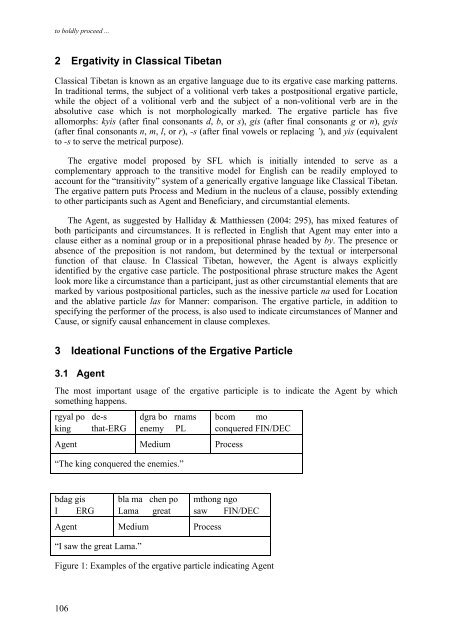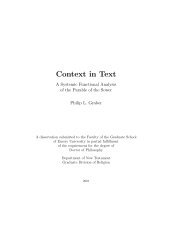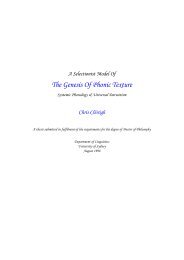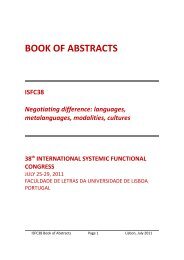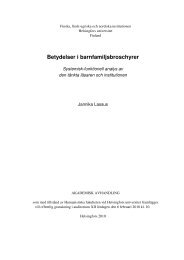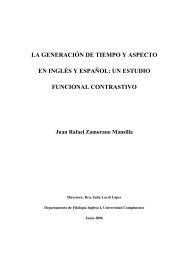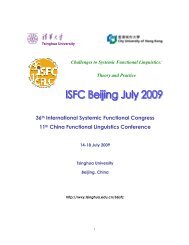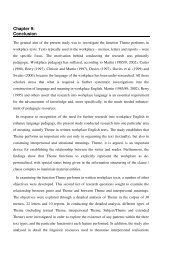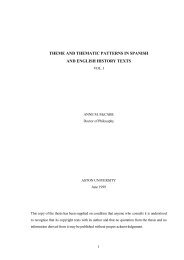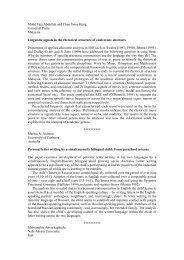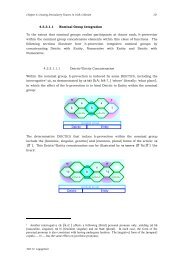the ISFC39 Proceedings - International Systemic-Functional ...
the ISFC39 Proceedings - International Systemic-Functional ...
the ISFC39 Proceedings - International Systemic-Functional ...
Create successful ePaper yourself
Turn your PDF publications into a flip-book with our unique Google optimized e-Paper software.
to boldly proceed ...2 Ergativity in Classical TibetanClassical Tibetan is known as an ergative language due to its ergative case marking patterns.In traditional terms, <strong>the</strong> subject of a volitional verb takes a postpositional ergative particle,while <strong>the</strong> object of a volitional verb and <strong>the</strong> subject of a non-volitional verb are in <strong>the</strong>absolutive case which is not morphologically marked. The ergative particle has fiveallomorphs: kyis (after final consonants d, b, or s), gis (after final consonants g or n), gyis(after final consonants n, m, l, or r), -s (after final vowels or replacing ’), and yis (equivalentto -s to serve <strong>the</strong> metrical purpose).The ergative model proposed by SFL which is initially intended to serve as acomplementary approach to <strong>the</strong> transitive model for English can be readily employed toaccount for <strong>the</strong> “transitivity” system of a generically ergative language like Classical Tibetan.The ergative pattern puts Process and Medium in <strong>the</strong> nucleus of a clause, possibly extendingto o<strong>the</strong>r participants such as Agent and Beneficiary, and circumstantial elements.The Agent, as suggested by Halliday & Matthiessen (2004: 295), has mixed features ofboth participants and circumstances. It is reflected in English that Agent may enter into aclause ei<strong>the</strong>r as a nominal group or in a prepositional phrase headed by by. The presence orabsence of <strong>the</strong> preposition is not random, but determined by <strong>the</strong> textual or interpersonalfunction of that clause. In Classical Tibetan, however, <strong>the</strong> Agent is always explicitlyidentified by <strong>the</strong> ergative case particle. The postpositional phrase structure makes <strong>the</strong> Agentlook more like a circumstance than a participant, just as o<strong>the</strong>r circumstantial elements that aremarked by various postpositional particles, such as <strong>the</strong> inessive particle na used for Locationand <strong>the</strong> ablative particle las for Manner: comparison. The ergative particle, in addition tospecifying <strong>the</strong> performer of <strong>the</strong> process, is also used to indicate circumstances of Manner andCause, or signify causal enhancement in clause complexes.3 Ideational Functions of <strong>the</strong> Ergative Particle3.1 AgentThe most important usage of <strong>the</strong> ergative participle is to indicate <strong>the</strong> Agent by whichsomething happens.rgyal po de-sking that-ERGdgra bo rnamsenemy PLAgent Medium Process“The king conquered <strong>the</strong> enemies.”bcom moconquered FIN/DECbdag gisI ERGbla ma chen poLama greatAgent Medium Process“I saw <strong>the</strong> great Lama.”mthong ngosaw FIN/DECFigure 1: Examples of <strong>the</strong> ergative particle indicating Agent106


